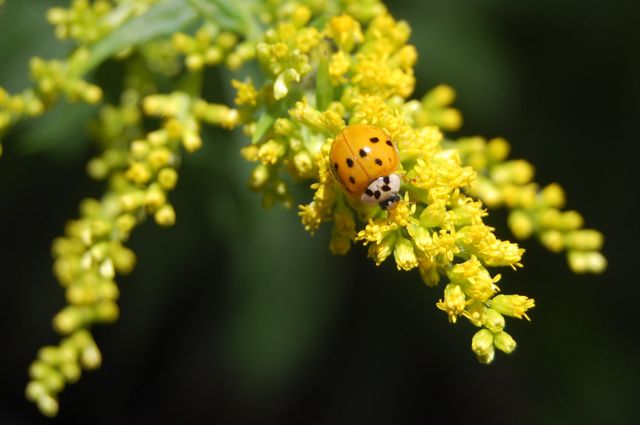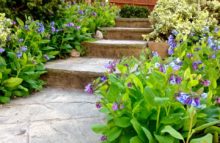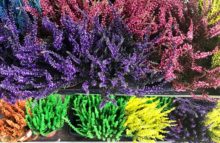| Ontario’s native floral symbol Trillium grandiflorum – can you be sure it was responsibly propagated? |
Is choosing native plants always the right thing to do for the planet? Si
mple answer, right? Well, after a couple of recent encounters, I’m surprised. The simple answer turns out to be more than a little complex.
When are native plants NOT the answer? was the title of the January 2011 Edwards Lecture at the Toronto Botanical Garden, and speaker Belinda Gallagher laid out the issues pretty comprehensively.
As the former head of horticulture for the Royal Botanical Gardens, Belinda oversaw the creation of a major native plant installation in 2008, the Helen M. Kippax Garden. She now runs her own horticultural consulting business Hooked on Horticulture, and co-developed the University of Guelph’s new program on Sustainable Urban Horticulture and Agriculture. So she’s dealt with the philosophy and practise of this topic more than most of us.
 |
| Do the many, many new cultivars of native species such as Echinacea count as natives, too? |
For example: What are native plants, anyway?
With the state of the world right now, most of us want to do the right thing. “Native plant” has a motherhood ring about it. But Belinda cautions us that it isn’t always easy to know what that means. Some plants have been naturalized so long in North America, it’s hard to know if they pre-dated European arrival.
Besides, she asks, how long does a plant have to be here before it’s native – since the last glaciation? She cited Robinia pseudoacacia or black locust, which they’re now finding pre-Ice Age evidence of in our region. It didn’t renaturalize quickl
y after the ice disappeared. But because it was reintroduced by man, it’s now labelled aggressively invasive. Is it a native?
Every plant has roots in a native plant somewhere, Gallagher reminds us. But what about nativars, or cultiva
rs of native plants? Do they provide the same ecological role of their native parents? She stresses that the science just isn’t in yet to support or dispute. Rather than jumping on the bandwagon and trusting the source, we should exercise caution, especially when planting nativars near natural stands of natives. Will cross-pollination between these hybrids and true natives cause harm?
 |
| Plant families are huge, with cousins on many continents. So, would you know whether or not this Polygonatum is our native North American Solomon’s seal? |
Driven by garden trends and our wish to do right, the demand for native plants has become such big business – far greater than our handful of true native plant growers can supply – that the “native” solomon’s seal we buy in the nurseries might actually be an Asian or European species grown in Holland or South Africa or Ecuador. Leaving aside the question of its heritage, how long would such a plant survive in our tough Canadian climate? We should be asking questions about provenance.
When Belinda Gallagher was planting the Helen Kippax native plant garden, she estimated that as much as 60% – that’s a shocking sixty percent – of the native plants were mis-labelled: from non-North American species to nativars labelled as natives.
Her lecture dovetailed neatly into a conversation I had over coffee with Sam Benvie, landscape ecologist and infectious tree guy at Ryerson and York Universities. Here’s his bio from an upcoming talk March 17, 2011 at Mississauga’s Applewood Garden Club: An ecological basis for residential planting design.
One of the things we discussed was the difficulty of defining that oft-used word: biodiversity. People usually think it means having a diversity of species in a certain area. Yet, Sam says we should think more deeply: 1,000 acres of typical urban landscape contains far more species than the same area of boreal forest. So, what does biodiversity mean? Even within the forest area, he notes, is there the right diversity of factors such as species
gender or reproductive age? Again, not simple.
 |
| Goldenrod, or Solidago, is a native we sometimes wish we could do withou
online pharmacy buy paxil with best prices today in the USA
t. This particular ladybeetle, however, is an Asian import (you can tell by the W or M shape just behind her head). |
Right plant, right place – that garden mantra was the underlying message of Belinda Gallagher’s presentation. We seem to give native plants miraculo
us properties. But they will not grow sustainably where conditions are unsuitable – just like any other plant.
Endangered spaces don’t get as much notice, but few of us in Toronto live in the conditions of the native oak savannah that once occupied our city. So what really is native to our evolved environment? Our first job is to understand our growing conditions – and select the right plant (which might well be a native plant) for the space you have.
So let’s be informed consumers. A plant bearing a native label isn’t a panacea. Ask questions about its origins. Stay tuned to the debates that will be unfolding about this issue. It’s huge, with many grey areas. Look beyond the easy answers from those to stand to gain most from our ignorance or indifference.
Things to consider as we look at those plant catalogs.





9 comments
It is a complex question. I prefer to grow native plants, and I try to get the local genotype as much as possible (local meaning within 100 miles of my garden), but I'm not adverse to nativars that are merely genetic variations on a native plant. Double-flowered cultivars don't count as native in my book because they aren't as pollinator friendly.
It's disturbing to learn about the mislabelling problem.
A very thought provoking piece, thank you.
In the UK, native is considered to be ice-age or prior to that. It means hardly any of the plants available as choices for gardeners are native and if we went down the totally native line our gardens would be far poorer – not just aesthetically.
Often 'choose native' is cited here and the reason given is because more species are supported by these plants (another facet of biodiversity). However, that isn't necessarily so e.g. buddliea and Echinacea (like MMD I'd just go for single blooms) are well known butterfly attracting plants. Neither are native to the UK.
Provenance is becoming an issue over here too. Sudden Oak Death menas that many plants which are potential carriers have to be quarantined and there's a growing 'Grow British' movement in support of our hard pressed home nurseries.
The issues raised here are set to run and run…
First, thank you for taking the time to report on this talk. I was hoping you would. It relates to an article I read on the Plants Nouveau website about natives, and how there is so much misinfo out there about how 'easy' they can be to grow. The link to that article is at http://www.plantsnouveau.com/2010/03/12/natives-are-easier/ and is worth a gander at too.
I love native plants, and nativars, and naturalized plants too…but all things with moderation and common sense, which sadly many gardeners are lacking.
Mislabelling is endemic in all aspects of plant propagation, I guess. Like the 'Green Dragon' amaryllis that are bright red. 🙁
In our pursuit to have the newest and the rarest, we often lose sight of why most of us garden– to take care of the world around us. Belinda does a good job at explaining why we need to ask questions about what plants we put in our gardens. Thanks for spreading her point of view to a wider audience.
Excellent points to consider. Thank you for this informative post.
Hi Helen,
Thanks for keeping me up to date on what is happening at the TBG, I miss all the great lectures.
Hi,
I was googling for something and somehow I landed at this beautiful bog. It was a beautiful Sunday morning treat to visit your pages, back and forth, and see all these gorgeous flowers and useful info.
Have a blessed Sunday!
The topic of native plants has certainly evolved over the past few years as more and more people realize how many layers there are to the issue. Thanks for writing such a thought-provoking post.
This is just the tip of the issues, but a very good lead-in. I have propagated true "native" species for more than 15 years and the whole field is not straightforward.
1. Our cultural demands are largely responsible for the state of use of these plants.
2. Mis-labelling does not affect sales, so it is almost the rule, rather than an exception.
3. . . .
Good blog.